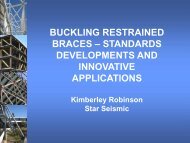Environmental Impacts of Multi-Storey Buildings Using Different ...
Environmental Impacts of Multi-Storey Buildings Using Different ...
Environmental Impacts of Multi-Storey Buildings Using Different ...
Create successful ePaper yourself
Turn your PDF publications into a flip-book with our unique Google optimized e-Paper software.
- 102 -Regional Council has put in place regulations preventing the use <strong>of</strong> treated timber inparticleboard production.Wood-plastic and wood-cement composites are another potential application <strong>of</strong> recycledtreated timber. Wood-cement composites can include cement-bonded particleboard, woodfibre cement boards, concrete construction blocks, acoustic barriers and ro<strong>of</strong> tiles. In general,these products perform well, in some cases better than alternatives using untreated wood.Properties such as susceptibility to leaching, bending strength and stiffness can be improved.Wood-plastic composites are at a very early stage and therefore little is known about theirpotential properties. Ultimately however, wood-cement and wood-plastic composites aremerely shifting the problem <strong>of</strong> difficult waste further along the life cycle. Waste disposal <strong>of</strong>these composites could pose further problems at the end <strong>of</strong> these products’ lives.Mulch and compost are other potential uses for treated timber waste. However, with thesurface area vastly increased, and a high exposure to water, the risk <strong>of</strong> leaching <strong>of</strong> chemicalsfrom CCA-treated timber is likely to be multiplied many times.8.6.4 Extended Producer Responsibility (EPR)Extended producer responsibility (EPR) is a concept which places the responsibility for theend-<strong>of</strong>-life environmental impacts <strong>of</strong> a product on the producer. This involves facilitatingreturn <strong>of</strong> the product to the producer, followed by processing to recycle what is possible andminimise waste. In New Zealand EPR schemes exist for cellphones, unused paint andwhiteware. Internationally, schemes exist for end-<strong>of</strong>-life vehicles, electronic equipment,packaging, batteries and others. Treated wood would be an excellent target for an EPRscheme as it is a waste that is potentially hazardous, takes up unnecessary space in landfills,and has the potential for energy recovery. Also with the Waste Minimisation (Solids) Billappearing before parliament, producers are becoming aware <strong>of</strong> the need to be responsible withtheir waste.New Zealand currently has no timber EPR schemes in place for either untreated or treatedtimber.However, the upcoming Waste Minimisation Bill specifies that the Waste MinimisationAuthority will be set up, which will collect a Waste Disposal Levy. This levy will be chargedat the time <strong>of</strong> disposal <strong>of</strong> waste, and will fund the authority, as well as funding projects toassist with waste minimisation.The Waste Minimisation Bill contains a section on EPR (though it uses the terms EPR andproduct stewardship interchangeably). This Bill does not propose legislation for compulsoryproduct stewardship/EPR schemes; it focuses on the compulsory participation <strong>of</strong> a produceronly if a product stewardship/EPR scheme already exists. This participation would includeprovision <strong>of</strong> collection facilities, and a minimum recycling, reuse or material recovery rate <strong>of</strong>75% <strong>of</strong> end-<strong>of</strong>-life products received at these recycling facilities. The bill also states thatsufficient notice will have to be given if there is an intention to consider the need for aproduct stewardship programme for a product.
















